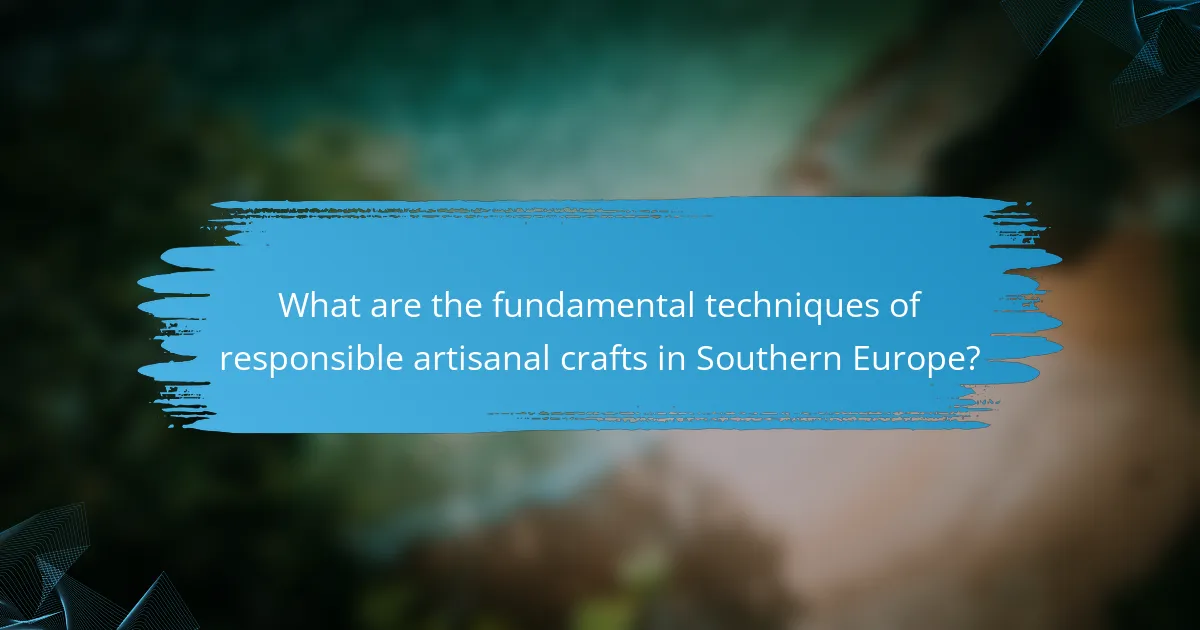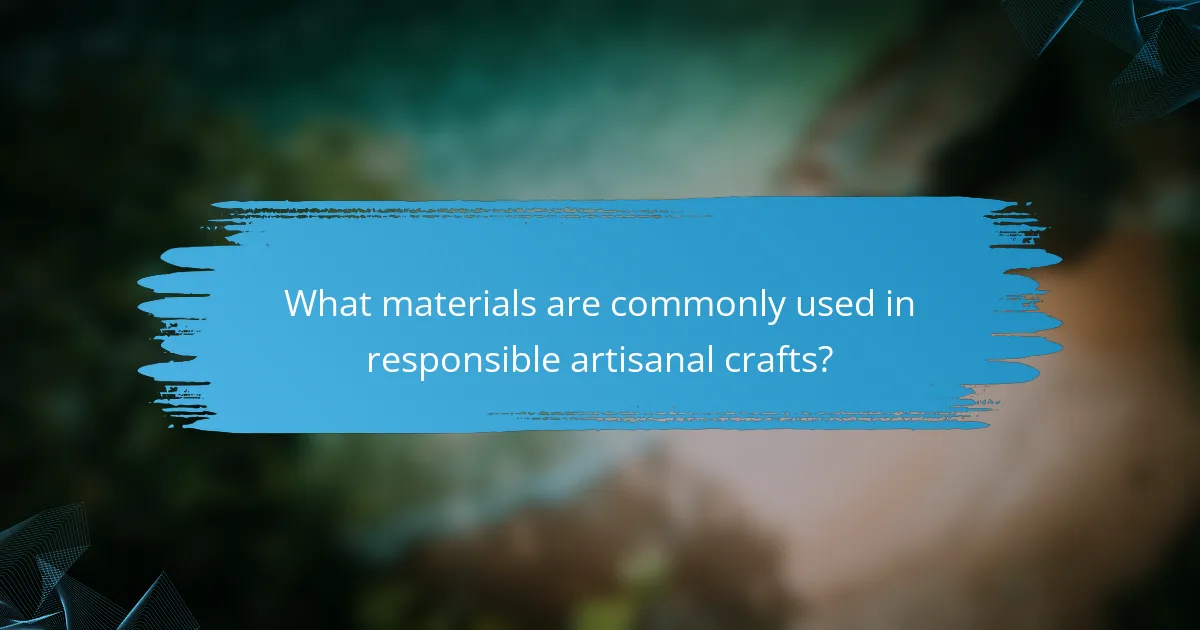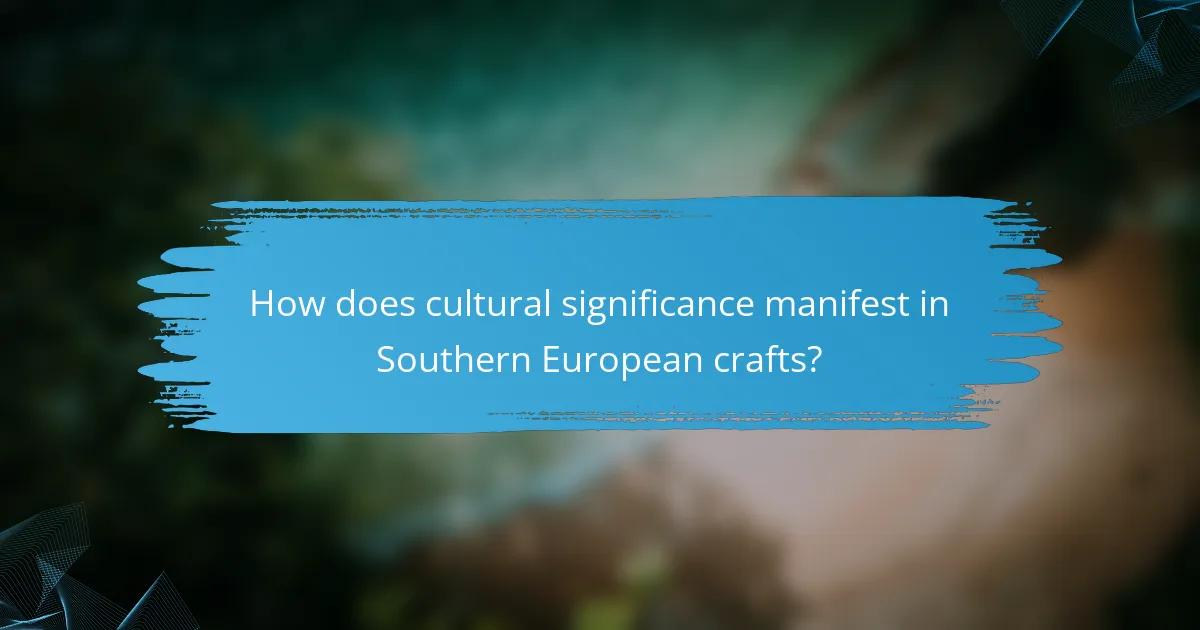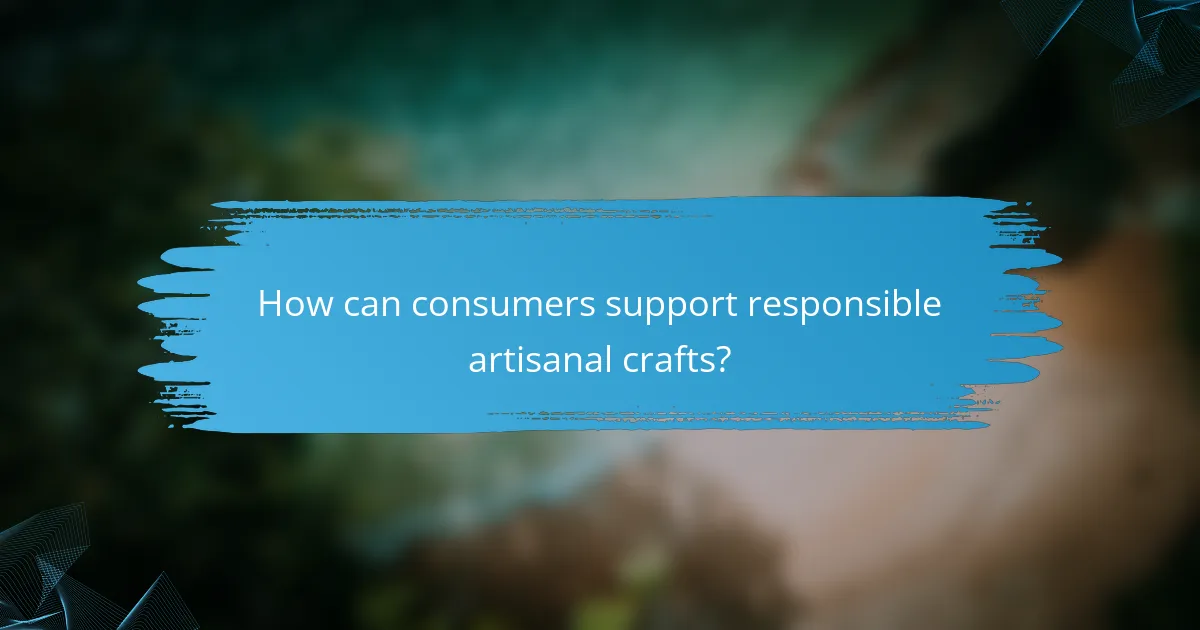Responsible artisanal crafts in Southern Europe promote sustainability and cultural heritage. This article explores key techniques like hand-weaving and pottery, highlights the use of natural materials, and examines the cultural significance of these crafts. It also addresses challenges artisans face and offers ways consumers can support responsible practices.

What are the fundamental techniques of responsible artisanal crafts in Southern Europe?
Responsible artisanal crafts in Southern Europe utilize techniques that emphasize sustainability, tradition, and cultural heritage. Key techniques include hand-weaving, pottery, and woodworking, which often involve natural materials like clay, wood, and fibres. These crafts promote environmental stewardship by minimizing waste and using locally sourced materials. Cultural significance is evident as these crafts preserve regional identities and foster community ties. For example, traditional hand-weaving techniques not only create functional items but also reflect the unique artistic expressions of local artisans.
How do traditional methods influence modern practices?
Traditional methods significantly shape modern practices in responsible artisanal crafts in Southern Europe. These methods emphasize sustainability, local materials, and cultural heritage. For instance, artisans often use techniques passed down through generations, ensuring the preservation of unique craftsmanship. This continuity fosters a deep connection to local identity and environmental stewardship. As a result, modern crafts often reflect traditional aesthetics while incorporating contemporary design elements, bridging past and present.
Which tools are essential for artisans in this region?
Essential tools for artisans in Southern Europe include hand tools, crafting machines, and natural materials. Key tools are chisels for woodwork, pottery wheels for ceramics, and weaving looms for textiles. These tools enhance craftsmanship while preserving cultural traditions.

What materials are commonly used in responsible artisanal crafts?
Common materials in responsible artisanal crafts include natural fibres, reclaimed wood, clay, and metal. These materials promote sustainability and reflect local cultural heritage. Natural fibres like cotton and linen are favoured for their biodegradability. Reclaimed wood reduces waste and adds unique character. Clay is often used in pottery, showcasing traditional techniques. Metal, particularly recycled options, emphasizes durability and craftsmanship.
How do local resources shape material choices?
Local resources significantly influence material choices in responsible artisanal crafts in Southern Europe. Artisans often select locally sourced materials that reflect their cultural heritage and environmental sustainability. For example, the use of regional clay in pottery connects to traditional techniques and local identity. Additionally, the availability of natural fibres, like wool from local sheep, enhances the authenticity of textile crafts. These choices not only preserve cultural significance but also promote economic sustainability within communities.
What are the environmental impacts of material sourcing?
Material sourcing for responsible artisanal crafts in Southern Europe can significantly impact the environment. Sustainable practices reduce resource depletion and minimize pollution. Artisans often use locally sourced materials, which lowers transportation emissions and supports local ecosystems. Techniques such as natural dyeing and handcrafting further decrease chemical waste. By prioritizing eco-friendly methods, artisans contribute to biodiversity conservation and promote cultural heritage.

How does cultural significance manifest in Southern European crafts?
Cultural significance in Southern European crafts manifests through traditional techniques, local materials, and regional styles. These crafts reflect historical narratives and social identities, preserving cultural heritage. Techniques often passed down generations create a sense of community and continuity. Materials sourced from local environments enhance authenticity and sustainability, connecting artisans to their landscapes. Unique attributes like intricate patterns or specific weaving methods highlight regional diversity. As a result, these crafts serve not only as functional objects but also as expressions of cultural identity and artistic expression.
What role do community traditions play in artisanal practices?
Community traditions significantly enhance responsible artisanal crafts in Southern Europe by preserving techniques and materials. These traditions foster a sense of identity and continuity, connecting artisans to their cultural heritage. For instance, local festivals often celebrate specific crafts, ensuring knowledge transfer between generations. This cultural significance not only enriches the artisans’ work but also promotes sustainable practices aligned with community values. Ultimately, community traditions serve as a foundation for innovation while honouring historical methods.
Which festivals celebrate artisanal crafts in Southern Europe?
Festivals celebrating artisanal crafts in Southern Europe include the Fiera di Sant’Oronzo in Italy, the Feria de Abril in Spain, and the Festival of Crafts in Greece. These events showcase traditional techniques, local materials, and cultural significance, highlighting craftsmanship and community engagement. For instance, the Fiera di Sant’Oronzo features handmade ceramics and textiles, while the Feria de Abril emphasizes flamenco crafts and artisanal food. Each festival enriches the cultural landscape by preserving and promoting unique regional crafts.

What are the unique attributes of artisanal crafts in specific Southern European regions?
Artisanal crafts in Southern Europe exhibit unique attributes such as traditional techniques, local materials, and cultural significance. Each region showcases distinct craftsmanship styles that reflect its heritage. For instance, the intricate ceramics of Andalusia emphasize vibrant colours and patterns, while Tuscany is renowned for its handwoven textiles. These unique attributes not only differentiate the crafts but also preserve local traditions and promote sustainable practices. The craftsmanship often incorporates rare materials, such as specific types of clay or indigenous plants, enhancing their uniqueness and value.
How do regional styles differ in craftsmanship?
Regional styles in craftsmanship vary significantly, reflecting local traditions and available resources. Techniques differ, with some regions emphasizing hand-tool methods, while others adopt modern machinery. Materials used are often sourced locally, resulting in unique textures and colours specific to each area. Cultural significance shapes these crafts, as artisans incorporate historical motifs and practices, preserving heritage. For example, Southern Italy showcases intricate ceramics that tell stories of local folklore, while Spanish artisans focus on vibrant textiles that celebrate regional festivals.
What are the distinctive features of crafts from coastal versus inland areas?
Coastal crafts often utilize materials like shells and fish leather, while inland crafts focus on wood and textiles. Coastal artisans emphasize techniques like weaving nets and fishing traps, whereas inland artisans may prioritise pottery and woodworking. Cultural significance varies, with coastal crafts reflecting maritime traditions and inland crafts showcasing agrarian lifestyles.

What are the rare attributes that enhance the value of these crafts?
Rare attributes that enhance the value of responsible artisanal crafts in Southern Europe include unique local materials, traditional techniques passed down through generations, and cultural narratives that reflect regional identities. These attributes create distinctiveness and authenticity, making the crafts more desirable. For instance, the use of indigenous plants for dyeing fabrics offers a rare ecological connection. Additionally, limited production runs ensure exclusivity, further elevating their market value.
How do limited-edition pieces contribute to cultural heritage?
Limited-edition pieces enhance cultural heritage by preserving traditional techniques and materials. These crafts reflect regional identities and stories. Their scarcity creates value, fostering appreciation and connection to history. Artisans often incorporate unique attributes, ensuring each piece carries a distinct narrative. This practice encourages sustainable methods and community engagement, reinforcing cultural significance in Southern Europe.
Which artisanal crafts are facing extinction and why?
Many artisanal crafts in Southern Europe face extinction due to modernization and declining demand. Traditional techniques, such as hand-weaving and pottery, are increasingly replaced by mass production. The unique cultural significance of these crafts is at risk as younger generations prioritise different careers. Additionally, the loss of local materials impacts the sustainability of these crafts, further threatening their survival.

What challenges do artisans face in maintaining responsible practices?
Artisans face significant challenges in maintaining responsible practices, including sourcing sustainable materials, preserving traditional techniques, and competing with mass production. Economic pressures often drive them to compromise on quality and ethics. Additionally, market demand for lower prices can overshadow the cultural significance of their crafts. Education on responsible practices remains limited, further complicating their efforts.
How do economic pressures affect artisanal integrity?
Economic pressures can compromise artisanal integrity by prioritising profit over traditional techniques. Artisans may reduce quality, use cheaper materials, or abandon cultural practices to meet market demands. This shift threatens the authenticity and cultural significance of crafts in Southern Europe. Maintaining responsible practices is essential to preserve these unique attributes amidst economic challenges.
What strategies are artisans using to overcome these challenges?
Artisans are using innovative techniques and sustainable materials to overcome challenges in Southern Europe. They are prioritising eco-friendly practices, such as sourcing local materials and minimising waste. Collaboration with local communities enhances cultural significance and market reach. Additionally, they are leveraging digital platforms for wider distribution and audience engagement. This approach not only preserves traditional craftsmanship but also adapts to modern consumer demands.

How can consumers support responsible artisanal crafts?
Consumers can support responsible artisanal crafts by prioritising purchases from local artisans and choosing sustainable materials. Engaging with artisans directly fosters community ties and ensures fair compensation. Additionally, consumers should educate themselves about the cultural significance of crafts, promoting awareness and appreciation. Supporting workshops and craft fairs enhances visibility for artisans and their techniques. Lastly, sharing positive experiences on social media can inspire others to value and support responsible artisanal practices.
What are the benefits of purchasing artisanal products?
Purchasing artisanal products supports local economies and preserves cultural heritage. These products often utilize traditional techniques and high-quality materials, ensuring unique craftsmanship. Artisanal goods foster sustainability through ethical production practices, reducing environmental impact. Additionally, they offer consumers a personal connection to the maker, enhancing the value of the purchase.
How can consumers identify ethically produced crafts?
Consumers can identify ethically produced crafts by examining the sourcing, production methods, and cultural significance. Look for certifications or labels that indicate fair trade practices. Engage with artisans to understand their techniques and material choices. Transparency in the supply chain is crucial; ethical producers often share their stories and values. Supporting local artisans enhances cultural heritage and promotes sustainable practices.
What best practices should consumers follow when engaging with artisans?
Consumers should prioritise ethical sourcing, support local artisans, and understand the cultural significance of the crafts. Engaging responsibly fosters sustainability and preserves traditions. Research artisans’ techniques and materials to appreciate their unique attributes. Always ask questions to deepen your understanding and connection with the craft.